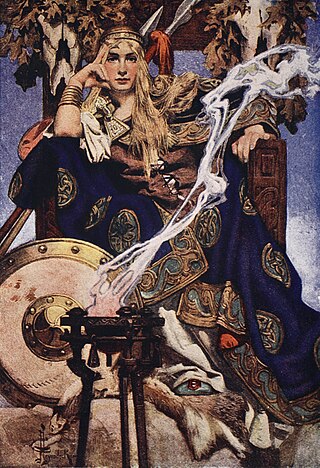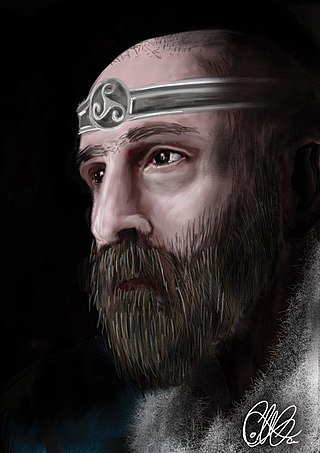Related Research Articles

Conchobarmac Nessa is the king of Ulster in the Ulster Cycle of Irish mythology. He rules from Emain Macha. He is usually said to be the son of the High King Fachtna Fáthach, although in some stories his father is the druid Cathbad, and he is usually known by his matronymic, mac Nessa: his mother is Ness, daughter of Eochaid Sálbuide, King of Ulster.
Cú Roí mac Dáire is a king of Munster in the Ulster Cycle of Irish mythology. He is usually portrayed as a warrior with superhuman abilities and a master of disguise possessed of magical powers. His name probably means "hound of the plain/field", or more specifically, "hound of the battlefield". He is the son of Dáire mac Dedad, and thus belongs to the Clanna Dedad. However, T. F. O'Rahilly believed this to be artificial, stating that "Cú Roí and Dáire are ultimately one and the same".

Cú Chulainn, is an Irish warrior hero and demigod in the Ulster Cycle of Irish mythology, as well as in Scottish and Manx folklore. He is believed to be an incarnation of the Irish god Lugh, who is also his father. His mother is the mortal Deichtine, sister of king Conchobar mac Nessa.

Fergus mac Róich/Róigh is an Irish hero and a character in the Ulster Cycle of Irish mythology. Formerly the king of Ulster, he is tricked out of the kingship and betrayed by Conchobar mac Nessa, becomes the ally and lover of Conchobar's enemy, queen Medb of Connacht, and joins her expedition against Ulster in the Táin Bó Cúailnge. Fergus is described as being of huge size and sexual potency. This leads him into many a precarious situation as in the story of the Táin Bó Flidhais.

Medb, later spelled Meadhbh, Méabh(a) and Méibh, and often anglicised as Maeve, is queen of Connacht in the Ulster Cycle of Irish mythology. Her husband in the core stories of the cycle is Ailill mac Máta, although she had several husbands before him who were also kings of Connacht. She rules from Cruachan. She is the enemy of Conchobar mac Nessa, king of Ulster, and is best known for starting the Táin Bó Cúailnge to steal Ulster's prize stud bull Donn Cúailnge.

Ailill mac Máta is the king of the Connachta and the husband of queen Medb in the Ulster Cycle of Irish mythology. He rules from Cruachan.

The Ulster Cycle, formerly known as the Red Branch Cycle, is a body of medieval Irish heroic legends and sagas of the Ulaid. It is set far in the past, in what is now eastern Ulster and northern Leinster, particularly counties Armagh, Down and Louth. It focuses on the mythical Ulster king Conchobar mac Nessa and his court at Emain Macha, the hero Cú Chulainn, and their conflict with the Connachta and queen Medb. The longest and most important tale is the epic Táin Bó Cúailnge. The Ulster Cycle is one of the four 'cycles' of Irish mythology and legend, along with the Mythological Cycle, the Fianna Cycle and the Kings' Cycle.
Bricriu is a hospitaller (briugu), troublemaker and poet in the Ulster Cycle of Irish mythology.
Bélchú of Breifne is a warrior of Connacht in the Ulster Cycle of Irish Mythology.
Cairbre Nia Fer, son of Rus Ruad, was, according to medieval Irish legend and historical tradition, a King of Tara from the Laigin.
Cet mac Mágach is a Connacht warrior in the Ulster Cycle of Irish Mythology. He had a rivalry with the Ulster warrior Conall Cernach.
Fráech is a Connacht hero and demigod in the Ulster Cycle of Irish mythology. He is the nephew of Boann, goddess of the river Boyne, and son of Idath of the men of Connaught and Bébinn, and is renowned for his handsomeness and exploits. He belongs to the Fir Domnann.
In the Ulster Cycle of Irish mythology, Lóegaire Búadach is a hapless Ulster warrior who mainly functions as comic relief. When he, Cúchulainn and Conall Cernach contend for the champion's portion at Briccriu's feast, Lóegaire is always a distant third. He lived at Inber Seimne.
Findabair or Finnabair was a daughter of Ailill and Queen Medb of Connacht in Irish mythology. The meaning of the name is "white phantom". The Dindsenchas also mention a Findabair who is the daughter of Lugaid Laigde.
The Táin Bó, or cattle raid, is one of the genres of early Irish literature. The medieval Irish literati organised their work into genres such as the Cattle Raid, adventure (Echtra), the Voyage (Imram), the Feast, the Wooing (Tochmarc), the Conception (Compert) and the Death (Aided), rather than the familiar but relatively modern division into cycles.
Fled Bricrenn is a story from the Ulster Cycle of Irish mythology. Bricriu, an inveterate troublemaker, invites the nobles of the Ulaid to a feast at his new bruiden at Dún Rudraige, where he incites three heroes, Cúchulainn, Conall Cernach, and Lóegaire Búadach, to compete for the "champion's portion" of the feast. The three heroes perform several feats, and travel to Connacht to be judged by Ailill and Medb, and to Munster to be judged by Cú Roí; on each occasion, Cúchulainn is proclaimed champion, but the other two refuse to accept. Eventually, back at Emain Macha, the three heroes are each challenged by a giant churl to cut off his head, on the condition that they allow him to cut off their heads in return. First Lóegaire, then Conall, takes up the challenge and cuts off the churl's head, only for him to pick it up and leave, but when the churl returns the following night they are nowhere to be seen. Only Cúchulainn lives up to his side of the bargain. The churl spares his life, reveals himself to be Cú Roí in disguise, and announces that Cúchulainn's bravery and honour make him an undisputed champion.
The Curadmír, modern Curadhmhír was an ancient custom referred to in early Irish literature, whereby the warrior acknowledged as the bravest present at a feast was given precedence and awarded the choicest cut of meat. This was often disputed violently. The custom appears most often in the legends of the Ulster Cycle. It is parallelled by historical customs of the ancient Celts of continental Europe, as recorded by classical writers.
Mac Cécht is the patronymic or cognomen given to one or two warrior champions from Connacht in the Ulster Cycle of early Irish literature. The personages may be identifical or may have been conflated at some stage, although the connection is nowhere made explicit and different fathers are ascribed to them in the tales.
The Tale of Mac Da Thó's Pig is a legendary tale in the Ulster Cycle.
References
- ↑ Dictionary of the Irish Language , Compact Edition, Royal Irish Academy, 1990, p. 109
- ↑ O'Brien, Kathleen M. "Index of Names in Irish Annals: Conall". Index of Names in Irish Annals. Retrieved 30 November 2019.
- ↑ "Archived copy" (PDF). Archived from the original (PDF) on 3 March 2016. Retrieved 24 July 2016.
{{cite web}}: CS1 maint: archived copy as title (link) - ↑ Whitley Stokes (ed. & trans.), "Cóir Anmann", Irische Texte series 3 vol. 2, 1897, p. 393-395
- ↑ N. Kershaw Chadwick (ed. & trans.), "The Story of Mac Dathó's Pig", An Early Irish Reader, Cambridge University Press, 1927
- ↑ Tom Peete Cross & Clark Harris Slover (eds.), "Bricriu's Feast" Archived 5 March 2017 at the Wayback Machine , Ancient Irish Tales, Henry Holt & Company, 1936, pp. 254-280
- ↑ A. H. Leahy (ed. & trans), "The Cattle Raid of Fraech" Archived 2013-12-30 at the Wayback Machine , Heroic Romances of Ireland vol. II, David Nutt, 1906.
- ↑ Whitley Stokes, "The Siege of Howth", Revue Celtique 8, 1871, pp. 47-63
- ↑ Kuno Meyer (ed. & trans.), "The Death of Conchobar" Archived 2013-12-26 at the Wayback Machine , The Death-Tales of the Ulster Heroes, Todd Lecture Series, 1906
- ↑ Tom Peete Cross & Clark Harris Slover (eds.), "The Death of Cu Chulainn" Archived 2013-11-29 at the Wayback Machine , Ancient Irish Tales, Henry Holt & Company, 1936, pp. 333-340
- ↑ Kuno Meyer (ed. & trans), "The Death of Cet mac Mágach" Archived 2013-12-26 at the Wayback Machine , The Death-Tales of the Ulster Heroes, Todd Lecture Series, 1906
- ↑ R.I. Best, "The Battle of Airtech", Ériu 8, 1916, pp. 170-190
- ↑ 'Flannacán mac Cellaig rí Breg hoc carmen. His poem on the death of some Irish heroes', by Kathleen Mulchrone, in "Journal of Celtic Studies", Vol I (1949-50), pp. 80-93, stanza 12.
- ↑ Kuno Meyer (ed. & trans.), "The Cherishing of Conall Cernach and the Deaths of Ailill and of Conall Cernach", Zeitschrift für celtische Philologie 1, 1897, pp. 102-111
- ↑ James MacKillop, Dictionary of Celtic Mythology, Oxford University Press, 1998, p. 87
- ↑ "The Death of Conall Cernach at Ballyconnell, Co. Cavan", by Tom Smith, in Breifne Journal 2012
- ↑ T. F. O'Rahilly, Early Irish History and Mythology, Dublin Institute for Advanced Studies, 1946, p. 350
- ↑ Margaret E. Dobbs, 'The Traditions of Conall Cernach' in The Journal of the Royal Society of Antiquaries of Ireland, Sixth Series, Vol. 19, No. 2 (Dec. 31, 1929), pp. 116-127
- ↑ Geoffrey Keating, Foras Feasa ar Éirinn 1.40
- ↑ Ó Súilleabháin, Seán (2011). Miraculous Plenty Irish religious Folktales and Legends. University College Dublin. p. 40. ISBN 978-0-9565628-2-1.